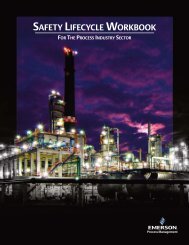jfq-76
jfq-76
jfq-76
You also want an ePaper? Increase the reach of your titles
YUMPU automatically turns print PDFs into web optimized ePapers that Google loves.
Mongolian police officer operates X26 taser during nonlethal weapons training at Five Hills Training Area, Mongolia, August 2013<br />
(U.S. Marine Corps/Ben Eberle)<br />
gaps; identifying and developing technologies<br />
into operationally suitable and<br />
effective less lethal solutions that are<br />
cost-effective; facilitating the acquisition<br />
and fielding of less lethal capabilities;<br />
advancing awareness of policy and public<br />
understanding through strategic communication<br />
and support for education<br />
and training; and efficiently managing<br />
resources and support. 8 However, despite<br />
18 years of activity and millions of dollars<br />
spent, most of the NLW that have been<br />
adopted by the military are commercial<br />
off-the-shelf systems produced for the law<br />
enforcement market (for example, Taser<br />
X26, Long-Range Acoustic Device, and<br />
FN 303 riot gun) rather than a product<br />
of JNLWP research and development. 9<br />
Moreover, the flagship of the JNLWP’s<br />
activity and investment, the Active Denial<br />
System, has never been used. 10<br />
Today it seems that the promised revolutionary<br />
change offered by NLW is still<br />
far out. This raises the obvious question<br />
of whether these systems are necessary on<br />
the current and future battlefield because<br />
only the existence of such a necessity<br />
could justify efforts to improve the current<br />
detrimental situation with NLW.<br />
Does the U.S. Military<br />
Need NLW?<br />
An understanding of the necessary<br />
military capabilities requires a comprehensive<br />
analysis of current and future<br />
threats, possible adversaries, broad political<br />
and military environments, and many<br />
other noteworthy factors. In an attempt<br />
to answer the question of the relevance<br />
of NLW on the modern battlefield, this<br />
article analyzes three primary official<br />
documents that consider all required<br />
aspects and define current and future<br />
military environments: the Joint Chiefs<br />
of Staff’s Capstone Concept for Joint<br />
Operations: Joint Force 2020 (CCJO);<br />
DOD Defense Science Board’s Challenges<br />
to Military Operations in Support<br />
of U.S. Interests (CMOSUSI); and U.S.<br />
Army Training and Doctrine Command<br />
(TRADOC) Pamphlet 525-66, Force<br />
Operating Capabilities (FOC).<br />
The purpose of CCJO is to provide<br />
general guidelines for future force development<br />
and describe the future operating<br />
environment. Its main concept, globally<br />
integrated operations, defines how the<br />
joint force should prepare itself for the<br />
future security environment. Describing<br />
one of the key elements of this concept,<br />
the CCJO states:<br />
Future Joint Operations will be increasingly<br />
discriminate to minimize<br />
unintended consequences. The increased<br />
transparency of the future security environment<br />
. . . heightens the need for force to<br />
be used precisely when possible. . . . In the<br />
saturated information environment of<br />
tomorrow, even minor lapses in conduct or<br />
application of fires could seriously damage<br />
the international reputation of the United<br />
JFQ <strong>76</strong>, 1 st Quarter 2015 Fridman 73




